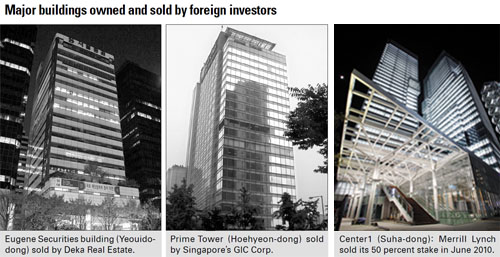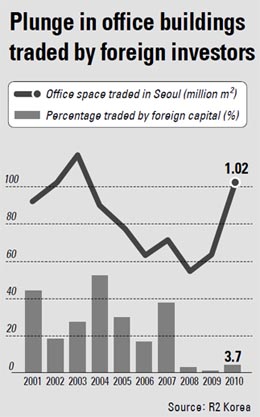Foreign investors flee local property market

Morgan Stanley’s real estate investment arm MS Capital closed its Korean office last year. Morgan Stanley reopened the Seoul Square building, the former Daewoo headquarters building, in 2009 after a yearlong renovation but the office space has still not been filled. There is speculation that the investment bank will sell the building.
Merrill Lynch sold half of its stake in Center1, a brand new high-rise office and commercial complex in Suha-dong, central Seoul.
“In the past, foreign investors bought and sold and then reinvested their capital gains in the local market, but nowadays they are not buying any more real estate,” said Kim Sang-tae, head of Bricks Asset.

Foreign investors started acquiring a large amount of property, which they considered undervalued, immediately after the 1997 Asian financial crisis. In early 2000, Lone Star Funds, the U.S. private equity fund, purchased Gangnam Finance Center in southern Seoul, formerly known as Star Tower.
It later posted an investment profit of 240 billion won ($221 million), which became a controversial issue.
However, there are now few property buyers. The percentage of office space transactions involving foreign investors fell to the single digits for the first time since 2007.
“More than ten years have passed since the Asian financial crisis, and foreign investors are now preparing to exit,” said an official at an investment consulting company.
Morgan Stanley has been one of the most active real estate investors in Korea since the Asian financial crisis. It bought and sold more than 10 buildings and also participated in developing the Songdo free economic zone in Incheon.
Merrill Lynch sold the SK Group headquarters building in March. It took more than 100 billion won in capital gains, but it has not reinvested in the country. Now it is reportedly planning an exit from the local market.
Wachovia Bank invested 12 billion won and took a 30 percent stake in building a theme park in Goyang, Gyeonggi, but it recouped its investment and collected 17.8 billion won, including a return of 5.8 billion won. The bank completely withdrew from Korea in July 2010 after it sold off real estate assets. Australia-based Macquarie Group sold the Geukdong building in Chungmuro, central Seoul, in 2009 and Smartplex building in Ssanglim-dong, Jung District, central Seoul, last year for 340 billion won. Since then it has not shown any interest in other investments.
“There are other investment banks trying to sell their property holdings, but no one is interested in buying,” said Choi Seung-hee, a real estate manager at Samsung Asset Management. “Most of the recent major property deals have involved domestic capital.”
Mirae Asset Global Investments bought Merrill Lynch’s stake in the Parc1 project in Yeouido, western Seoul. Geukdong building was acquired by the National Pension Service from Macquarie.
There are two good reasons for lack of interest in local property by foreign investors. After the 2008 global financial crisis, investment banks have become more cautious in their investments.
A bigger reason is the stagnant local property market. “Office space supply is growing but demand is on the decline,” said Hong Soon-man, an executive at Shinyoung Asset.
According to a survey based on the number of office workers in Seoul by the Korea Research Institute for Human Settlements, demand for office space in the capital is expected to grow to 49.7 million square meters this year, 49.8 million square meters in 2012 and 49.9 million square meters in 2013.
However, new office space in Seoul will increase by 10.6 million square meters this year and 10.7 million square meters next year. This is attributed to the boom in developing high-rise buildings in late 2000s. There is expected to be excess office supply until 2014.
By Hwang Jeong-il [jbiz91@joongang.co.kr]
한글 관련 기사 [조인스랜드]
외국IB들 "부동산 투자로 연 10% 수익 어렵다"
투자 여력 줄고 공급과잉으로 공실률 증가
경기도 남양주시에 대형 상가를 운용하고 있는 김모 사장은 요즘 골머리를 앓고 있다. 공동투자자인 미국의 와코비아(지난해 웰스파고에 합병)가 갑자기 상가를 팔겠다고 나선 때문이다.
김 사장은 “상가 임대를 85% 이상 채워 잘 돌아가고 있는데 처분하겠다니 당혹스럽다”며 “미국 본사에서 한국 부동산을 처분하라는 지침을 받았다는 말만 들었다”고 전했다. 와코비아를 인수한 웰스파고는 지난해 7월 부동산 부문을 한국에서 완전히 철수시켰다.
글로벌 투자은행(IB:Investment Bank)을 중심으로 한 외국계 투자자본이 국내 부동산을 사고팔아 시세 차익을 남기는 것은 어제 오늘의 일이 아니다.
미국계 사모펀드인 론스타가 2000년대 초반 서울 강남구 역삼동의 스타타워(현 강남파이낸스센터)에 투자해 2400억 여원의 차익을 남긴 사실은 사회적 이슈가 되기도 했다. 론스타는 이후 극동건설을 매입하는 등 재투자로 또 다시 수익을 챙겼다.
그런데 요즘 외국계 투자자본의 움직임은 예전 같지 않다. 재투자를 하지 않는다. 지금까지는 사고팔기를 반복했지만 요즘은 팔고 그냥 나가버리는 것이다. 할 일이 없어진 한국 지사의 부동산팀도 슬그머니 사라지고 있다.
사는 것은 없고 내다팔기만…
사지는 않고 파는 게 대세다. 투자자문업체의 한 관계자는 “외환위기 이후 시작된 외국인들의 10년 투자가 끝물이라는 느낌을 받고 있다”고 말했다.
모간스탠리는 외환위기 이후 국내 부동산에 가장 공격적으로 투자한 회사였다. 10여 년간 10여 건의 빌딩을 사고 팔았을 뿐 아니라 인천 송도 국제업무지구 개발에 참여하기도 했다.
지금 남은 유일한 자산은 서울스퀘어(옛 대우빌딩)다. 이 마저도 싱가포르 업체에 관리를 맡기고 철수했고, 최근엔 팔려고 내놨다는 소문도 돌았다.
2008년 뱅크오브아메리카(BOA)에 인수된 미국의 IB 메릴린치는 서울 수하동의 대형 오피스 빌딩 센터원 지분(50%)을 지난해 하반기 모두 처분했다. 메릴린치는 또 2005년 사들인 서울 서린동 SK그룹 본사 건물을 올 3월말 팔았다. 이 빌딩을 팔아 시세차익을 1000억원 정도 올렸으나 재투자는 하지 않고 있다.
경기도 고양시 한류월드의 테마파크 조성사업에 30% 지분 참여를 했던 와코비아는 원금 120억원에 2년8개월간의 투자수익금 57억7000만원을 포함한 177억7000만원을 회수한 뒤 한국에서 완전히 빠졌다.
장기 투자를 위해 들어온 IB들도 슬슬 빠지고 있다. 호주의 맥쿼리는 2009년 서울 충무로 극동빌딩에 이어 지난해 중구 쌍림동 스마트플렉스 빌딩을 국민연금공단에 3400억원에 판 이후 다른 부동산 매입에는 관심이 없다. 대표적 장기투자회사인 싱가포르투자청도 지난해 서울 중구 회현동에 있는 프라임타워(옛 아시아나빌딩) 빌딩을 1420억원에 팔았다.
외국계 투자자본은 외환위기 이후 부동산 시장이 살아나던 2000년대 초 본격적으로 들어왔다. 투자 대상은 주로 외환위기 때 가격이 급락한 대형 오피스나 상가였다. 값이 오르면 내다팔아 시세차익을 얻으려는 게 투자목적이었다.
그런데 요즘에는 목적이 어떻든 대형 오피스 시장에서 이런 행태는 찾아보기 어려워졌다. 삼성자산운용 정승회 부동산투자팀장은 “내다 팔려는 IB는 있어도 사려는 외국계 자본은 거의 없다”며 “최근 거래된 대형 오피스 빌딩도 대개 국내 자본이 매입했다”고 말했다.
실제 지난해 4분기 서울에서 거래된 연면적 5000㎡ 이상 빌딩 대부분을 한국기업이나 기관이 사들였다. 메릴린치가 판 파크원 지분은 미래에셋자산운용이 사들였고, 맥쿼리가 처분한 극동빌딩은 국민연금이 매입했다. 서린동 SK그룹 빌딩 역시 SK그룹이 되사갔다.
이유 있는 ‘셀 코리아’
전문가들은 외국계 투자자본이 떠나는 이유를 크게 두 가지로 본다. 우선 2008년 터진 서브프라임 모기지 사태(금융위기) 이후 IB들의 투자 여력이 크게 위축됐다. IB의 투자는 대개 자산보다는 여러 투자자들로부터 돈을 모은 뒤 투자하는데, 리먼브러더스의 와해를 본 투자자들이 IB에 돈 대기를 꺼리게 된 것이다.
더 큰 이유는 이들의 주요 투자 대상인 국내 빌딩 시장에 있다. 신영에셋 홍순만 상무는 "수요는 줄어드는 데 공급은 늘어 투자 여건이 예전 같지 않다"고 지적했다. 국토연구원이 서울 사무직 근로자 수를 토대로 서울의 오피스 수요 면적을 추산해보니 올해는 4966만㎡, 2012년 4981만㎡, 2013년 4988만㎡, 2014년 4988만㎡가 필요한 것으로 나타났다.
그런데 서울에서만 올해 1058만㎡가 추가로 공급되고 내년에는 1071만㎡가 더 나올 것으로 추산된다. 즉 내년에는 올해보다 오피스 수요가 15만㎡ 정도 늘 것으로 예상되나 공급은 71배나 많은 1071만㎡인 것이다. 이런 현상은 2014년까지 이어진다. 2000년대 후반 고층 빌딩 개발 붐이 일면서 공급이 일시에 몰린 탓이다.
이러다보니 공실률(빈 사무실 비율)도 늘고 있다. 2007년 이전까지 서울 빌딩 공실률은 2~3% 정도에 머물렀다. 사실상 공실이 없었던 셈이다. 그러나 글로벌 금융위기 이후 공실이 늘기 시작해 올 1분기에는 5.7%(알투코리아 조사)에 이르렀다. 전문가들은 기업 사옥으로 쓰이는 빌딩을 제외한 순수 임대 목적의 빌딩 공실률은 8~9%에 이를 것으로 예상한다.
투자 수익이 예전같지 않은 것은 당연하다. 독일 유니온인베스트먼트는 서울 여의도 하이투자증권빌딩을 지난해 7월 국내업체에 548억원에 팔았다. 4년간의 투자성적표는 수익률 36%지만 그들의 기대에는 미치지 못했다. 서울스퀘어는 지금 팔면 투자비도 건지지 못할 정도라고 전문가들은 내다본다.










with the Korea JoongAng Daily
To write comments, please log in to one of the accounts.
Standards Board Policy (0/250자)